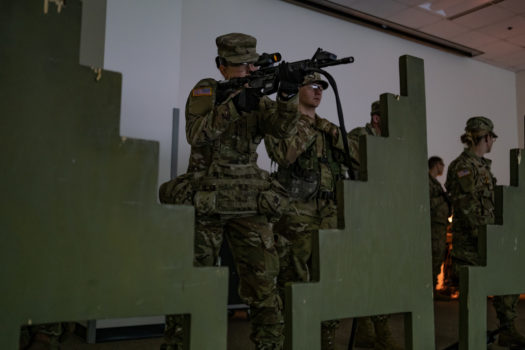More than 300 Cadets from 2nd Regiment filed in through a single door leading into a large room at the Engagement Skills Trainer building, empty save for easels with instructional material and a Humvee roll-over training aid. The Cadets were ready to attempt the training after having gone through preliminary marksmanship instruction yesterday.

EST uses a digital range with modified M4A1 carbines that fire a laser at simulated targets to test a Cadet’s accuracy and technique.
“It’s a great way to get our Soldiers out and simulate effective range training,” said Maj. Yul Heredia,“ but in a digital capacity.
“It saves time,” the platoon training officer said. “It’s much more efficient in regards to the resources and constraints that are typically applied to a range.”
According to Heredia, such constraints include the use of actual ammunition. Since a digital range doesn’t require the expenditure of live rounds, Cadets can hone their marksmanship skills without wasting rounds. It also allows them to get more reps in, so that when they finally arrive at the range, they can be more effective.
Lastly, Heredia noted, the EST can simulate shooting at day or night, regardless of the hour, and can be used 24/7, as necessary.
Among 2nd Regiment, was Cadet Haley Polk from Wichita State University, who shared her enthusiasm about the training exercise.

“I’ve done it a couple of times before,” Polk said, “I’m excited to beat my last score.”
Polk’s previous attempt at the EST netted her a score of 29 out of 40 on the digital range. In order to qualify, or pass, the EST, a Cadet must hit their targets at least 23 out of 40 times. Polk’s previous score qualified her as a marksman. Polk hoped to best her old score of 29 with a 34 or higher on today’s test.
Polk was prior enlisted as an intelligence analyst out of Lanny J. Wallace with the 647 Regional Support Group for almost four years. After her test, Polk was mostly satisfied with her results.
“I did good. I didn’t get the score that I wanted to — I got a 33 and not a 34. I’m a little bummed but I can’t be that bummed,” Polk said.
A score of 33 qualified Polk as a sharpshooter on the EST. Sharpshooter required a minimum score of 30 out of 40. The highest qualification is expert, which requires Cadets to score a minimum of 36.

The EST sits in the middle of a stepped training system. Tomorrow, Polk and the rest of her regiment will head to a live-fire range, where they will group and zero their issued M4 carbines. Their time training at the EST aims at making them more effective on those days.




